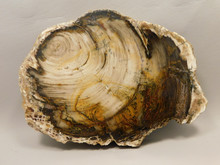Recently we bought a very large collection of Petrified Wood mostly self-collected in the Southwest United States from the 1950’s to the 1980’s. Though we have sold a lot of Petrified Wood through the years, we certainly aren’t experts, especially in so many varieties that are so rare now. While embarking on a mission to educate ourselves, so we can bring our customers the most accurate information, we thought-why not share everything we were learning with you?
So, I am starting a new monthly blog series all about Petrified Wood.
In this first installment I will discuss what Petrified Wood actually is and how it is formed.
Petrification generally means that organic material, in this case wood, is actually gradually over a long period of time changed into a rock by water containing inorganic elements or compounds seeping through it. It is technically a pseudomorph or chalcedony after wood. Experts use the term permineralization, rather than replacement. The rock may look just like the original wood, complete with “bark” and detailed cell structure inside. Sometimes you may just get a limb cast, where the tree rotted away and left a mold, that then it filled with chalcedony and though it has the original shape of the wood, it doesn’t retain the cell structure or interior details.
The conditions required in order for a tree or plants to be petrified are actually very rare. Only a small percentage of all the trees and plants that lived on earth have been petrified. In order to petrify, plants or tree trunks must be quickly be buried under several hundred yards of sediment: via a volcanic eruption, or a flood or mudslide. In fact, the vast majority of petrified forests occurred near volcanic action. The tree or plant has to be protected from oxygen, fungi, and insects-all of which lead to the tree or plant decaying quickly.
An abundant source of dissolved silica must be present. That silica is often presence due to the break-down of natural volcanic glass. Depending on the silica content in the ground it generally takes millions of years for trees to petrify. It is believed as many as 58 minerals can replace the wood. But by far the most common is silica and microcrystalline quartz (which includes chalcedonies- such as agates and jaspers). Next would be calcium carbonates (calcite), iron oxides, iron sulfides (pyrite and marcasite). Other minerals that permineralization wood are copper minerals (chrysocolla, chalcopyrite, covellite, and even native copper). Opalized wood is when the wood is replaced by opal, more often common opal (no play of color), but sometimes iridescent precious opal!
Angiosperms and gymnosperms are the two major groups of vascular seed trees and plants.
Gymnosperms are a smaller, more ancient group, and it consists of trees and plants that produce “naked seeds” (not protected by a fruit). There are more than 1,000 species of gymnosperms still growing on Earth. Gymnosperms include conifers and softwood trees. This does not actually mean the tree was “soft”. Softwood trees usually had needles (conifers) or scale-like leaves. Gymnosperm first appeared in the late Devonian Period and, in addition to conifers (pine, spruce, firs), include cordaites, cycads, ginkgo, and hermanophyton. Conifers grow in a variety of environments from tropical to high mountains and include the largest variety-the Sequoia redwoods.
The Angiosperm is a tree or plant that has flowers and produces seeds enclosed within a carpel (or fruit), including hardwood tress, or trees that have broad leaves. Angiosperms include herbaceous plants, fruit trees, shrubs, yuccas, palms, and grasses. The oldest angiosperm dates back to the lower Cretaceous Period, but in the Cretaceous, angiosperms diversified explosively, becoming the dominant group of plants across the planet. Angiosperms represent approximately 80 percent of all the known tree and plants now living
Both conifers and hardwoods have the ability to “thicken”, which results in the tree rings. A tree's growth rate or "thickening" changes throughout the year in response to seasonal climate changes, resulting in visible growth rings. Each ring marks a complete cycle of seasons, or one year, in the tree's life. These rings are often still visible in Petrified Wood. Other things that may be still visible are insect damage, fungus, etc. But we will discuss that more in a later blog!
Be sure and check back next month as we will be discussing the colors of Petrified Wood!
 US Dollar
US Dollar
 Australian Dollar
Australian Dollar
 Euro
Euro
 CAD
CAD

